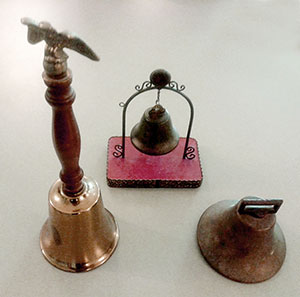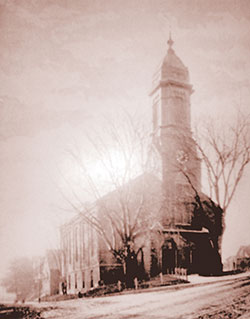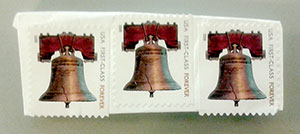
Eagle Feathers #81 – Bells
By Bob (Monty) Doherty
Last Halloween, the Somerville Theatre presented a production called Nevermore: An Evening With Edgar Allan Poe. Poe’s fascination with chimes led him to title one of his poems The Bells, wherein he invented the word tintinnabulation, which described their sound. Poe was born just three miles from Somerville in Boston.
How old you were, where you lived, and what you did, generally measured your memory of bells. Throughout time, bells have played a far-reaching part in our history but, sadly, those pleasant sounds seem to be disappearing. The ringing of them from steeples of churches and the belfries of public buildings once sent daily messages with a calming effect. They would awaken people in the morning, call them to dinner at noon, and lull them to sleep at night after curfew. They would call children to school, alert them of fire or approaching trains, or they would simply tell us the time of day in a pleasant sounding way. Little bells were put above babies’ heads in nurseries to amuse and calm them. Others were tied to animals’ collars to find them when they were lost. They were often rung for celebrations, public or private. They were rung after the D-Day invasion of France had commenced. They were rung at the end of all of our wars, at Christmastime and, of course, on the Fourth of July.

In June, 1903, the Liberty Bell made a trip from its home in Philadelphia to the Bunker Hill Monument. It was displayed on the Boston Common, where 50,000 people gathered to view it. It travelled to numerous towns in the Boston vicinity, Somerville being one. Our Conway Park boasts with a photo of this event on one of its signs.
Bells were donated by groups and individuals. Mrs. Charles Tufts, wife of the University benefactor, gave her church the largest bell in the city. It was at the First Universalist Church located at the corner of Cross and Tufts Streets.

Eleven bells were hung in the First Congregational (Unitarian) Church, located next to the American Legion Post #19 on Highland Avenue. They were forged at the old Paul Revere’s foundry of Boston. Unfortunately, many of Somerville’s bells were lost during the World War II scrap metal drives.
Our terrible Civil War ended one hundred fifty years ago this year, and a special Somerville story is still told today about it. In 1863, President Lincoln signed the Emancipation Proclamation freeing all slaves. At that time, a free black gentleman from Somerville bought a bell at an auction at Boston harbor. This bell was one of many that were part of the cargo on a captured southern war supply ship. He brought his bell back to his Prospect Hill home, mounted it in a garden tree, and rang it in honor of freedom. Every year thereafter, he would celebrate Emancipation Day by ringing his bell throughout the day. He attended Saint Thomas’ Church, near the intersection of Somerville Avenue and Washington Street in Union Square. In his later years, he wanted to protect his treasured bell so it would continue to be heard. For this reason, he donated it to his church. Although his bell is gone and the church has been commercialized, you can still see the small turret on this building that housed his cherished Jubilee bell.
















Reader Comments